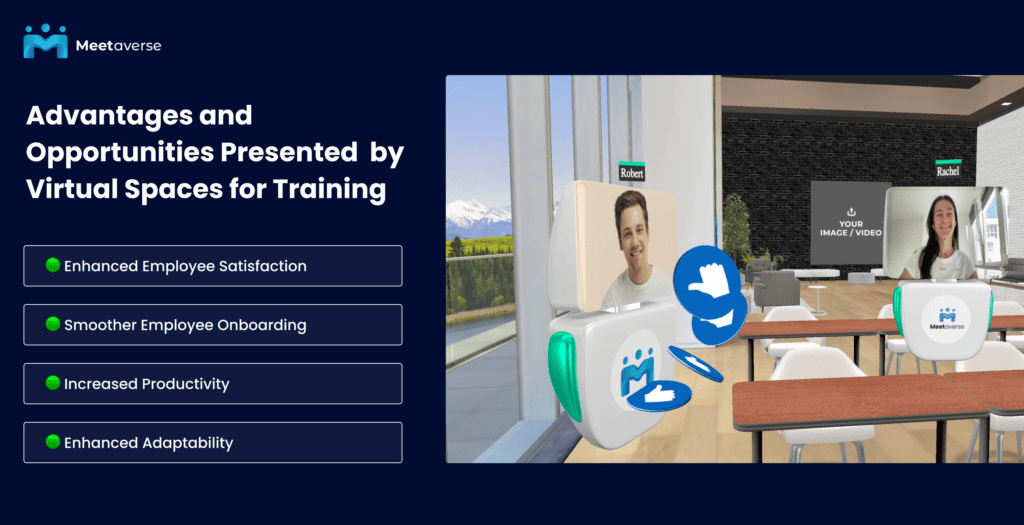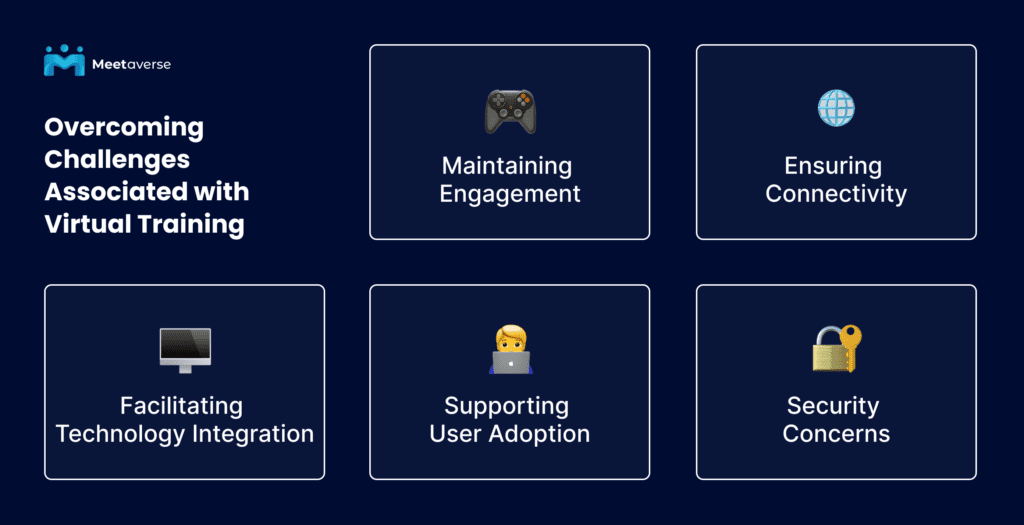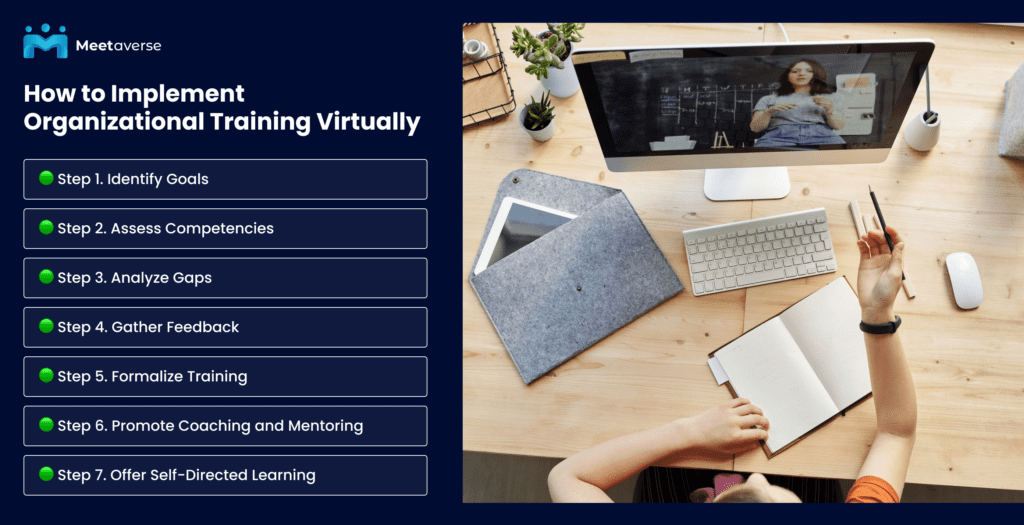
The business landscape nowadays evolves rapidly. Traditional training methods, often confined to classrooms and instructor-led sessions, are no longer keeping pace with the dynamic demands of the modern workplace. With their immersive and interactive capabilities, virtual spaces have emerged as a transformative force in organizational training, offering many engaging techniques and promising an exciting future for learning and development.
In this article, we will discuss the transformation of organizational training methods. We will provide innovative techniques to help your teams succeed in the digital age.
As organizations navigate the ever-changing landscape of today’s business world, their ability to adapt, innovate, and grow hinges on a critical element: the development and enhancement of their workforce’s skills and knowledge. Organizational training, a multifaceted and strategic approach to employee development, is the cornerstone of this transformation.
Let’s explain the role of training in an organization’s development:
Organizational training, also known as corporate training or employee training, is a systematic process of educating and developing employees to enhance their skills, knowledge, and competencies. It encompasses many activities, including remote onboarding programs, technical skill development, leadership training, and soft skills training.
Training and organizational development programs strive to achieve a variety of objectives and goals:

In essence, an effective organization training program is a strategic imperative. It positions the organization and its workforce for sustained success.
Organizational development and training (OD&T) stand at the forefront of corporate strategies. Its impact is in outcomes such as increased production and improved performance.
Investing in organizational training addresses skills gaps. Also, it prepares employees to adapt to new technologies, processes, and industry trends. This adaptability ensures that the workforce remains aligned with the company’s objectives.
The emergence of virtual spaces has revolutionized the way organizations conduct training, ushering in an era of unparalleled flexibility, accessibility, and interactivity. Once considered a niche or experimental approach, virtual training environments have become an integral part of modern organizational learning strategies.

Virtual spaces have revolutionized the way organizations conduct training. They offer a multitude of advantages and opportunities:

While there are a lot of benefits of virtual training, it also presents several challenges that organizations must address:

Organizations must recognize and embrace the potential of virtual training spaces. That will enhance their training programs and prepare for the future of work. Virtual training for employees offers a flexible, scalable, and cost-effective solution. By leveraging virtual spaces, organizations can foster a culture of continuous learning. That will empower their employees and achieve their strategic goals.
Organizations continue to embrace the power of virtual spaces. The future of organizational training is poised for even greater innovation and growth. The integration of AI (Artificial Intelligence) and machine learning, adaptive learning technologies, and personalized learning pathways will further enhance the effectiveness and scalability of virtual training programs.
Looking for a new and revolutionary L&D solution?
Leave your contact information and a Meetaverse professional will be happy to tell you more about how we can help
You need a strategic approach to install training in organizations in a virtual space. This organizational training plan helps you get the most out of training programs. These programs create opportunities for internal growth and mobility. Now, let’s look at the steps to implement virtual organizational training.
The first important step is to identify clear business goals. Goals may include improving skills, increasing productivity, or adapting to industry changes. Defining goals will guide the entire training program.
Determine the most important skills for both the organization and employees to succeed. Find these key skills. That will make sure the training program matches the organization’s goals.
Do you want to create an effective training program? First, understand the workforce by identifying knowledge gaps. This analysis helps customize the content to improve specific areas.
Include employees in the process. You can do that by collecting feedback on their own goals in the company. This way, we can make sure that the training program is interesting and relevant to the workforce.
Start a formal training program after completing assessments. The program includes in-person sessions led by instructors and online courses. This combination of teaching methods suits different learning styles. It also makes the training material easier to access.
Create mentoring and coaching programs to encourage relationships between employees. These programs help transfer knowledge. Besides, they create a supportive learning environment, especially for new workers.
Virtual training should include self-directed learning. This helps different learning styles and speeds up professional development. Moreover, it maximizes the return on investment in training expenses.

Meetaverse is a leading provider of virtual organization training and development solutions, offers a comprehensive suite of tools and services to empower organizations in implementing effective and engaging virtual training programs.
Advantages of the Meetaverse platform:
Meetaverse goes beyond mere training spaces. It provides persistent virtual spaces meticulously tailored for all your employee solutions. This means you gain a lasting connection hub to enhance communication, foster collaboration, and drive business success.

Book a demo now to see how Meetaverse can make training engaging, flexible, and cost-effective with valuable insights.
Do you want to make organizational training effective? It is important to create an interesting virtual training environment. Using interactive methods and advanced technologies improves the learning experience.
The future of organizational training is poised for continued transformation. Emerging technologies and evolving learners need to drive it. Here’s a glimpse into the exciting trends shaping the future of virtual training:

Also to these technological advancements, organizations will need to embrace a culture of agility. If they want to thrive in the future of training. This includes:
A shift towards will characterize the future of organizational training:
The future of organizational training is promising. It relies on emerging technologies, continuous learning, and a commitment to agility. Organizations should use strategies on how to improve training and development.
Organizational training is undergoing a transformative shift. The rise of virtual spaces and emerging technologies drives it. Embrace engaging techniques, leverage virtual environments, and foster a culture of continuous learning by which organizations can empower their workforce. The world of training continues to evolve. Organizations that adapt will be best positioned to achieve the success of their goals.
Looking for a new and revolutionary L&D solution?
Leave your contact information and a Meetaverse professional will be happy to tell you more about how we can help
Organizational training is important for several reasons:
Organizational training is the process of providing employees with the skills and knowledge they need to perform their jobs effectively. This training can be delivered in a variety of formats, including classroom instruction, online courses, on-the-job training, and mentoring.
The role of training organization is to help employees develop the skills and knowledge they need to achieve the organization’s goals. This includes helping employees to:
The basic concept of training in an organization is that it is an investment in the organization’s most valuable asset – its employees. By investing in training, organizations can help to ensure that their employees have the skills and knowledge they need to be successful in their jobs. This can lead to improved productivity, reduced errors, and increased customer satisfaction.
Organizational training examples include:
The training process in an organization typically consists of the following steps:
The corporate world has undergone significant changes due to employee virtual tr...
read moreHR enters the metaverse, and it plays a critical role in facilitating the integr...
read more


